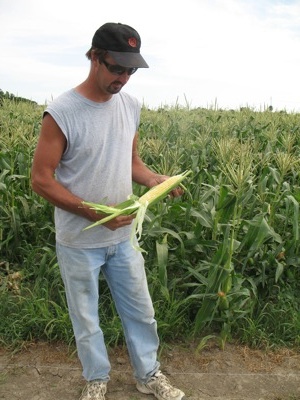Tuesday, July 17th, 2007
Plan to improve Grand Lake watershed starts with farmers
By Nancy Allen
At first look, the many initiatives included in an action plan for the Grand Lake/Wabash River watershed looks insurmountable, but some are readily doable and are already being addressed, said a lake official.
"There was a lot of stuff that was thrown out there, but I think some of them are achievable and some are already being worked on," said Grand Lake St. Marys State Park Assistant Manager Brian Miller during Monday's Lake Restoration Committee meeting. "Some we have almost already met or are close."
Agriculture initiatives rank highest in importance in the watershed action plan submitted to the state recently for endorsement.
Theresa May, former coordinator of the Grand Lake/Wabash Watershed Alliance, and now a technician with the Mercer County Soil and Water Conservation District, gave a presentation on the plan during Monday's meeting. Also attending was newly-hired watershed coordinator Laura Walker.
The roughly 500-page plan compiles all the needs of the watershed to improve water quality.
Comments are expected back from the state by mid August, May said.
The plan includes several initiatives, divided between agricultural, non-agricultural and capital improvement.
Some of the initiatives included in the plan already being addressed include reducing over application of lawn fertilizer, getting manure management technology in the watershed and pursuing grant money to help landowners implement best management practices on their land, May said.
These initiatives are being addressed through a workshop slated this week for people to learn proper lawn fertilization techniques, the securing of a $10,000 grant to test a manure separating device called a Geotube on a local dairy and at Maria Stein Grain on different types of manure, and the submission of a $900,000 U.S. EPA grant to implement conservation throughout the watershed. Officials are still waiting to see if the watershed group receives the grant that was applied for last fall.
Plan initiatives:
Agricultural
• Installing 5,000 acres of conservation tillage in the watershed within three years (currently only about 16 percent of the land is conservation tilled).
• Planting 2,000 acres of winter cover crops within three years.
• Planting 300 acres of filter strips and 500 acres of filter recharge areas within five years.
• Identifying all dairies that discharge milkhouse waste and correct the illegal activity by installing wetlands or storage facilities.
• Constructing and restoring 60 acres of wetlands throughout the watershed in five years.
• Completing comprehensive nutrient management plans for 75 percent of the livestock producers in the watershed (currently just 10 to 20 percent have them).
• Installing 100 tile control structures within five years.
• Incorporating manure management technology on a livestock farm within the next five years.
• Promoting the installation of grass waterways in areas of evident gully erosion.
• Stabilizing 2,000 feet of streambank using natural channel design within the next five years.
Non-agricultural
• Replacing 50 failing or compromised septic tanks in the watershed.
• Ensuring that sediment and erosion controls are being used at construction sites and getting the Ohio EPA more involved in enforcing this.
• Encouraging the use of retention/detention areas at development sites over 5 acres, which is actually a law.
• Investigating the use of rain gardens in housing developments to filter out sediment. These gardens contain certain plants that take up moisture and keep sediment in place.
• Reducing the over application of lawn fertilizer. Lawns only need nitrogen to stay green and most likely do not need phosphorous, which is found in abundance in the watershed and contributes to poor water quality.
• Continuing to work with groups to improve water quality.
• Providing education through presentations to local school children, civic groups, by hosting workshops, camps, field days, etc.
Capital improvement
• Stabilizing 6,000 feet of the lake's shore directly adjacent to naturally occurring wetlands.
• Encouraging continuation and expansion of the state's dredging program for the lake, especially once initiatives of the watershed action plan are implemented.
• Replacing septic systems in concentrated residential areas.
• Continuing the operating and maintenance of the five sediment traps installed in tributaries of Grand Lake.
• Encouraging development of a comprehensive lake level management plan for Grand Lake.
- Nancy Allen
